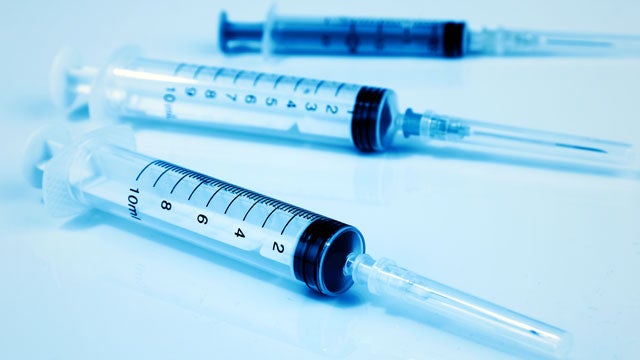Recently, and for the first time, the World Anti-Doping Agency (WADA) released a . The table- and data-laden report isn’t much fun to read, but for people involved in anti-doping campaigns, it was a gift. Prior to this report, comprehensive testing statistics have been publically unavailableŌĆöor at least very hard to track down. In some instances, testing agencies themselves didnŌĆÖt keep data; they had sent it all to WADA, and WADA didnŌĆÖt always like to share.
The most interesting section of the report covered data about the athlete biological passport, which debuted in 2009 as a next-generation test with the potential to revolutionize anti-doping. And in 2012, according to the report, drug testers collected more than 18,000 samples for biological passport analysis, almost three times the number collected in 2010. At the same time, the report also shows that traditional drug tests are on the decline. Last month, in the wake of American Chris Horner’s controversial victory at the Vuelta, the Spanish grand tour, the rider produced six years worth of biological passport data in an effort to clear his name. Some, however, believed the numbers only incriminated Horner further. Whatever the final conclusion, it’s good news for the bio passport. If it can prove innocenceŌĆöor guiltŌĆöit may be the most effective anti-doping tool yet developed.
Ok, so what is it?
In simple terms, the biological passport is a series of blood or urine screens taken over an extended period of time (like several years) and analyzed for the effects, rather than the presence, of drug use. In theory, the passport has , or modules: one that looks at blood doping, one that looks at steroid use, and one that looks at manipulation of the endocrine system (think Human Growth Hormone). Currently, the World Anti-Doping Agency has only issued guidelines for the blood module, but said last month that the steroid module would go live by year’s end. The endocrine module is still in development.
The passport differs from traditional drug testing in two key ways. First, it doesnŌĆÖt screen for any drugs. Second, it works over time. A single passport screen may not yield much information about doping, but 10 or 20 (or even 30) can reveal not only what drugs an athlete is taking, but when and for what purposes. For drug testers, thatŌĆÖs the holy grail.
How does the blood module work?
A drug tester, working for either a testing agency or a sportŌĆÖs governing body, pays a visit to an athlete (often unannounced) and draws a small amount of blood. The blood sample is cooled and then rushed to a testing lab for analysis. If samples arenŌĆÖt analyzed within 36 hours of collection they become useless. (This has made testing in places like East Africa, which is far from all of WADAŌĆÖs labs, quite a challenge.)┬Ā
Passport analysts then look for two things: the percentage in the sample of immature red blood cells, called reticulocytes, and the volume of mature red blood cells. (There is also a third measurement, referred to as an OFF-score, which is a ratio of those two numbers.) In healthy, non-doping humans, none of those values change a great deal. But in doped athletes they do. To understand why, youŌĆÖve gotta understand dopers.
All dopers in endurance sports are obsessed with red blood cells. Red blood cellsŌĆöor more specifically, a protein on the cells called ŌĆöcarry oxygen to muscles. The more RBCs an athlete has, the faster and longer they can race. There are several ways to blood dope, but the two most common involve using synthetic erythropoietin, or EPO, or transfusing blood. EPO and drugs like it work by telling the body to increase its red blood cell production. Blood transfusions are slightly more complicated. When an athlete removes some of his blood, his red blood cell count drops and his body rushes to make more cells in compensation. Like EPO, that makes his reticulocyte percentage jumps. But once those reticulocytes grow up into mature red blood cells, he transfuses his blood back inŌĆösay, on a rest day of a grand tourŌĆöand suddenly heŌĆÖs got a bunch more red blood cells than the guy trying to hold his wheel.
For the purposes of passport analysis, an athlete on EPO will have a , as will an athlete who has just removed blood for a transfusion. Later on, the transfusing athlete will have a too-high red blood cell count, and a lower reticulocyte percentage, which has been thrown out of whack by all the extra mature cells floating around.
Hematological scientists have observed that most people have reticulocyte percentages of between .5 and 1.5, and mature red blood cell counts of around 160g/l. Some people are naturally higher or lower, but the trick is watching for variationŌĆödramatic spikes or drops in either number are statistically unusual.
Put another way: All humans react similarly to blood manipulation, and that means taking EPO or transfusing blood messes with people in ways that are both predictable and mostly (but not entirely) specific to doping. So even though EPO often leaves the body before itŌĆÖs picked up by a drug test, and an athleteŌĆÖs own blood is essentially undetectable, the passport allows testers find evidence of both.
Is the blood module reliable?
Somewhat. For the passport to trigger a ban, testers like to show a pattern of manipulation. One instance of a high reticulocyte percentage could point to EPO, but also a recent trip to altitude; likewise, a higher-than-normal red blood cell percentage might mean a transfusion or that an athlete is dehydrated. To avoid these problems, athletes are instructed to say whether theyŌĆÖve recently trained at altitude, and testers are not supposed to collect samples within two hours of a training session or a race. In an email, Dr. Wolfgang Jelkmann, Director of the Institute of Physiology at GermanyŌĆÖs University of Luebeck, who has studied the blood module, called these ŌĆ£methodological weaknesses,ŌĆØ that result in ŌĆ£a relative high risk of false-positive results.ŌĆØ
In response, passport analysts use a complicated formula to account for altitude, the athleteŌĆÖs genetic background, and other environmental factors when parsing passport data. But given the risk of false positives, the analysis is made deliberately insensitive. The current standard is a 1-in1,000 sensitivity, meaning the passport will only result in a false positive in 1 out of 1,000 analyses (over a series of samples, that means the risk of false positive becomes very, very low) but it will also yield many false negatives. A more sensitive analysisŌĆöa standard that would yield 1 false positive in 100 testsŌĆöwould catch more cheaters. Testers may use this standard when deciding which athletes to target with drug tests, but it is the 1-in-1,000 sensitivity that is used to enforce doping bans. Since 2011, three cyclists have challenged the accuracy of the blood module in front of the Court of Arbitration for sport, and in each case the court .
One final word about false positives: because blood analysis must be performed so soon after collection, athletes donŌĆÖt get an opportunity to oversee the testing of a B sample as they would for a traditional drug test. WADA, however, does allow passport-sanctioned athletes to examine how their samples were analyzed, and labs must be able to prove that their equipment was functioning properly during each sample analysis. Depending on your perspective, though, the absence of a B-sample like procedure could be a cause for mild concern.
Has the passport succedeed in stopping or slowing blood doping?
Maybe. The bio passport gets a lot of credit for cleaning up cycling, but itŌĆÖs hard to know how much it deserves. Passport analysis played a key, although not decisive, role in USADAŌĆÖs case against Lance Armstrong, and this summer if figured prominently in a massive doping case against 31 runners in Turkey. In 2010 and 2011, the Science of SportŌĆÖs Ross Tucker might mean the passport was working as a deterrent. And, most recently, there was Chris Horner.
But there are skeptics. In 2011, Floyd Landis told reporters that athletes could take micro doses of EPO while transfusing blood and avoid triggering passport violations. A small dose of EPO taken during a transfusion flushes from of the body within hours and boosts reticulocyte percentages just enough to keep the off-score within allowable limits. Other riders .
Dr. Daniel Eichner, head of Salt Lake CityŌĆÖs Sports Medicine Research and Testing Laboratory, which handled more than 700 passport screens last year, says the current blood module will easily capture ŌĆ£gross manipulators,ŌĆØ people who are either inexperienced or careless when they dope, but doesnŌĆÖt work as well on sophisticated cheaters, particularly those with access to regular blood screens by their own doctors.┬Ā
That said, the passport isnŌĆÖt only for catching cheaters. ŌĆ£The passport program is a great way to fish where the fish are,ŌĆØ Eichner says. Testers could use the lower 1-in-100 threshold to figure out which athletes should be singled out for more conventional drug tests. ŌĆ£ItŌĆÖs a fantastic way for identifying who needs to be monitored more often,” Eichner says, “and over time what youŌĆÖll find is that if an athlete gets that kind of scrutiny, because they are cheating, theyŌĆÖll either get caught or theyŌĆÖll stop cheating.ŌĆØ Ross Tucker : we may never get everyone to drive the legal limit, but if everyone who was driving 100 miles per hour starts going, say, 80 itŌĆÖs still a major accomplishment.
WhatŌĆÖs next?
For starters, until the passport includes steroid and endocrine screens, it has little to say about the integrity of athletes in strength-and-power sports, not to mention endurance athletes who use steroids or HGH. But the steroid and endocrine modules need more research before receiving WADA approval, and research means giving healthy volunteers potentially harmful drugs. ŌĆ£In my mind,ŌĆØ Jelkmann says, ŌĆ£this has to be condemned. It is an ethical dilemma.”
And then thereŌĆÖs microdosing. ŌĆ£There is little doubt that it remains relatively easy for savvy athletesŌĆöespecially those who cooperate with well-skilled medical doctorsŌĆöto defeat the passport by taking small doses of recombinant EPO,ŌĆØ Jelkmann says. And newer versions of EPO, which came off patent several years ago, can be harder to detect in urine. So itŌĆÖs certain that some cyclists are taking small doses of EPO and getting away with it. Fortunately, thereŌĆÖs a new, , and with luck testers already have an idea about who those microdosing cyclists are.
But they might not. This summer USADA, which is based in Colorado Springs, was been prevented by the UCI from carrying out tests at the USAPC. And that points to bigger political and logistical fights in the battle against doping. Here are two telling examples: In 2009 and 2010, according to USADAŌĆÖs reasoned decision against Lance Armstrong, the UCI possessed passport data , but may have . (The UCI disputes this claim.) And last fall, news surfaced that the IAAF wasnŌĆÖt collecting passport data for many Kenyan and Ethiopian runners because it couldnŌĆÖt get samples to testing labs within the 36-hour window. That has left a huge gap at the top of the sport.
In an ideal world, all drug testing would be both managed and carried out by an independent outfit like USADA. In reality, it is governing agencies like UCI, IAAF, and FISŌĆöorganizations that donŌĆÖt always like to see positive tests publicizedŌĆöthat are doing the vast majority of passport screens. Cycling accounted for a third of the 18,000-plus passport screens performed in 2012. Skiing analyzed 1,874 samples. USADA performed just 700. Without independent verification, only the most flagrant and reckless cheaters will come to light.


